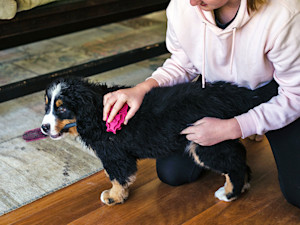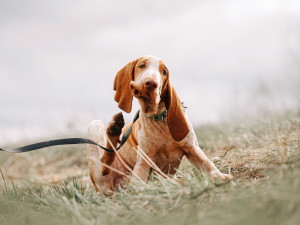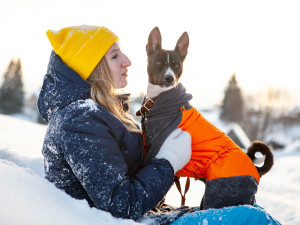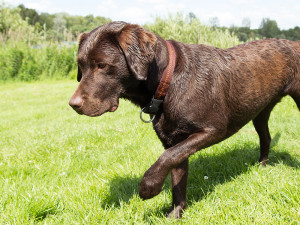Botflies On Dogs: How to Spot It And What to Do
Botflies, also known as warbles and wolf worms, burrow into your dog’s skin. (Sorry if you’re eating right now.)

Share Article
In This Article:
What Are Botflies?opens in a new tab How Common Are Botflies?opens in a new tab How Do Dogs Catch Botflies?opens in a new tab Signs Your Dog Has a Botfly opens in a new tab How to Treat a Botfly Infestation in Dogsopens in a new tab Complications of Botfly Infestations In Dogsopens in a new tab How to Care For Your Dog After You’ve Eradicated the Botfliesopens in a new tab How to Prevent Botflies in Dogs?opens in a new tab Frequently Asked Questionsopens in a new tab
Dogs are naturally curious creatures, often exploring areas where they shouldn’t go. Fields, burrows, and grassy areas where parasites can be found will lure your dog straight into trouble.
One of the most repulsive parasites your dog may run into is the botfly (Cuterebra). If your dog has one in their skin, it will appear as a swelling or hole and may have a botfly larva inside it. Learning to identify, treat, and prevent botfly infestations is important to keep your dog healthy and comfortable.

Get (totally free) deals for food, treats, accessories, tech, and way more pet parenting must-haves.
opens in a new tabWhat are botflies?
Botflies are parasitic insects. They are also called Cuterebra because they belong to the Cuterebra genus. Unlike ordinary flies, they don’t feed on blood or bites. These parasites usually target rodents, rabbits, and small mammals as their hosts. Dogs can become accidental hosts.
The botfly larvae can get into a dog’s skin through hair follicles, the nose, the eyesopens in a new tab, or a wound. The botfly larvae develop inside the dog, creating a warble, a swollen lump that is pus-filled and has a breathing hole. Once the larvae mature under the skin, they emerge as full-grown larvae.
How long can a botfly live on a dog?
Once under a dog’s skin, the larva usually lives from three to eight weeks before emerging, although it may stay longer, especially if they migrate internally. If the larvae migrate externally, when they emerge, they will drop to the ground, where they burrow into the dirt and pupate into an adult fly.
How common are botfly infestations in dogs?
Botfly infestations are not common but can occur, especially in rural areas and areas with a high population of rodents. As would be expected, dogs who wander freely outdoors and breeds with long hair and thick coats are more at risk of developing a botfly infestation, especially when it’s warm.
How dogs catch botflies
Botfly eggs infect dogs near rodent nests, burrows, or tall grass. Here’s how it happens:
The botfly lays eggs near a rodent’s burrow or in grassy areas.
A dog comes along and brushes against the area. This causes the eggs to hatch.
The tiny larvae crawl onto the dog’s skin. To get into the skin, the larvae penetrate through wounds, hair follicles, or mucous membranes.
The larvae develop, and a swelling or warble is created under the skin.
Dogs that are more at risk include dogs that enjoy digging, rolling in the grass, and hunting.
Signs your dog has a botfly (or many)
If you see warbles on your dog, think botfly infestation. There are other signs as well. Symptoms may include:
A swollen lump that has a small hole in the middle of it
Swelling, redness, or inflammation
Oozing discharge that sometimes has pus or blood in it
Your dog excessively licks or scratches themself.
Pain or sensitivity if the lump is touched
In severe cases, your dog may not want to eat opens in a new tab and become lethargicopens in a new tab. If the larva has migrated internally instead of into the skin, it can end up in the nose, brain, or eyes. Symptoms may include neurological issues, nasal discharge, or vision problems.
How to treat a botfly infestation in dogs
Regardless of how minor it looks, do not treat the botfly infestation yourself. Seek veterinary help as soon as possible. Some infestations may appear minor, but even those can lead to infections and complications with improper removal.
Can you remove botflies at home?
Most vets will caution you against removing botflies at home. That’s because most people will have the urge to squeeze the warble, but that can lead to severe infection by rupturing the larva. It’s also easy to leave a bit of the larva behind, and if it isn’t removed completely, it can lead to prolonged inflammation and tissue damage. Improper removal may increase the risk of secondary bacterial infections.
Veterinarians typically remove botflies by numbing the area with a local anesthetic to prevent pain and extracting the larva gently with forceps to prevent rupture. Infection can be treated or prevented by cleaning the wound and giving antibiotics.
Complications of botfly infestations in dogs
You must get the botfly removed by your vet right away. If you don’t, other complications can occur, including internal damage and infections. The most severe reactions occur when the larvae (warbles) migrate within the body rather than escaping from the skin. Here are some potential consequences:
Localized skin infections: When the botfly larvae burrow under the skin, they create something called warbles, swollen lumps with a breathing hole. The affected area may be inflamed, red, and painful. Secondary infections can occur if the dog scratches or chews the site. Bacteria can enter, leading to abscesses or deep infections.
Systemic reactions: Occasionally, a dog has an allergic reaction or a more severe hypersensitivity response.
Neurological issues (rare but severe): If a larva migrates to the brain or spinal cord, it can cause neurologic cuterebriasis, leading to seizures, ataxia (loss of coordination), circling or abnormal behavior, and sudden blindness.
Respiratory issues: If a botfly larva enters the nasal passages or throat, it may cause difficulty breathing, nasal discharge, frequent sneezing, or gagging.
Ocular and orbital myiasis: Rarely, larvae may invade the eye, causing inflammation, discharge, or even vision loss.
Can botflies transmit other diseases?
Fortunately, unlike most other parasites, botflies do not transmit diseases. However, serious infections from bacteria can occur. Abscesses and tissue death are examples.
Can a botfly kill a dog?
It is extremely rare, but severe infestations can be fatal. The larvae can migrate to the brain, resulting in feline ischemic encephalopathy. Even though the name has feline in it, it has been found in dogs. It is more commonly called neurologic cuterebriasis in dogs. In such cases, symptoms include seizures, disorientation, and behavioral changes.
Are botfly infestations contagious?
Botflies are not directly contagious from one dog to another. However, if another dog is in the same area, they can become infested, too.
How to care for your dog after you've eradicated the botflies
Proper wound care is necessary after botfly removal:
Keep the area clean and dry.
Give your dog antibiotics and pain medications as prescribed by your vet.
Prevent licking by having your dog keep an Elizabethan collar (E-collar) on.
Monitor for signs of infection (swelling, pus, worsening pain).
Schedule a recheck appointment with your vet if needed.
How to prevent botfly infestations in dogs
Prevention is key to avoiding botfly infestations:
Keep your dog far away from tall grass, rodent burrows, and fields.
After coming in from outdoors, check your dog’s fur and skin.
Use flea and tick preventatives, as some can deter botflies.
Keep your yard clean and discourage rodents from building nests.
Bathe your dog regularly and inspect them for unusual lumps.
Bottom line
Botflies are an unpleasant but treatable issue in dogs. Recognizing the symptoms early and seeking veterinary help ensures the best outcome for your pet. While rare, severe cases can lead to dangerous complications, so prevention and monitoring are key to keeping your dog safe.
FAQs
Can humans catch botflies from dogs?
Humans can accidentally become hosts, but they don’t transmit straight from dogs. Humans get infected just as dogs do by coming into contact with botfly eggs.
How do you get rid of botflies on a dog?
The best way to remove a botfly is through a veterinarian, who will safely extract the larva and treat the wound. Do not attempt to remove the larva yourself.
Are botflies harmful to dogs?
Yes, botflies can cause pain, infection, and complications. While a single botfly larva may not be life-threatening, internal migration can lead to severe health issues. See your vet right away if you find a botfly on your dog.
What does a botfly look like on a dog?
A botfly infestation appears as a swollen lump with a small hole in the center. Sometimes, you may see the larva moving inside the hole.
What happens if you don’t remove a botfly on a dog?
If left untreated, the botfly will continue to grow before emerging. However, secondary infections, abscesses, and inflammation can cause serious complications if the warble is left unattended.
References
Helkiö, K M, et a. “Botfly Cephenemyia Ulrichii Larvae in the Nasal Cavity and Nasopharynx of a Dog with Respiratory Signs.”opens in a new tab Journal of Small Animal Practice, vol. 64, no. 4, 29 Jan. 2023, pp. 306–309.
Park, Janice Y., et al. “Fatal Cerebral Cuterebrosis in a Dog.”opens in a new tab Veterinary Parasitology: Regional Studies and Reports, vol. 26, 11 Sept. 2021, p. 100636.
Slansky, Frank. “Insect/Mammal Associations: Effects of Cuterebrid Bot Fly Parasites on Their Hosts.” opens in a new tabAnnual Review of Entomology, vol. 52, no. 1, 1 Jan. 2007, pp. 17–36.

Dr. Shelby Neely, DVM
Dr. Shelby Neely is a freelance writer and veterinarian who graduated from The University of Pennsylvania and has practiced veterinary medicine for 30 years. She has found homes for hundreds of stray pets and has two cats as well as four grand-dogs and two grand-cats. In her spare time, Dr. Neely likes to be with her three children, their dogs and cats, and her own two cats. She also likes to see as many Broadway shows as possible.
Related articles
![Veterinarian checking large dog's skin and fur.]() opens in a new tab
opens in a new tabVet-Recommended Flea-and-Tick Treatments
Learn what is best for your pet.
![A dog cuddled up next to its owner on the couch]() opens in a new tab
opens in a new tabCertain Flea and Tick Meds Can Cause Adverse Reaction in Pets, FDA Warns
Some preventatives have been linked to neurological issues, like stumbling, seizures, and twitching in dogs and cats. Here’s what you need to know.
![A young woman walks with her dog in a winter park.]() opens in a new tab
opens in a new tabShould You Use Flea and Tick Prevention for Your Pet in the Winter?
You’ve got good ol’ climate change to thank for this answer.
![Hungarian pointer dog wears a Seresto Flea & Tick collar]() opens in a new tab
opens in a new tabIs Seresto’s Flea and Tick Collar Dangerous for Dogs?
The popular preventative has been linked to nearly 1,700 pet deaths. Here's what you need to know.
![A woman in beige overalls a striped shirt and a straw hat, smiling, with her arm around her black dog sitting in the grass on a green hill.]() opens in a new tab
opens in a new tabHow Did I Get a Flea Infestation? Causes and Prevention
Treatments to ward off transmission this spring and summer.
![Brown Labrador lifting front leg]() opens in a new tab
opens in a new tabHow to Get a Head Start on Your Pet’s Health
Spot lumps, limps, and lethargy early on.







